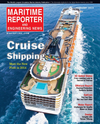
Something Old, Something New ...
I must admit that exploring the historical nature of our business is one of my favorite endeavors, and this month we are pleased to continue our series of articles in celebration of our 75th anniversary. Patricia Keefe again graces our pages with her overview of the creation and fate of what is arguably the greatest if not most famous ship in the history of U.S. shipbuilding, the passenger liner SS United States.
The SS United States is one of those ships that has intricately interwoven itself into the culture of this industry, and everyone that you talk to seems to know someone, or of someone, that sailed on the ship as a passenger or crew (including my wife Dawn, who’s great, great aunt served as a steward on the ship).
From its maiden voyage in 1952 to today, the ship continues to make headlines: then as a technological wonder, the fastest passenger vessel ever; now as the S.S. United States Conservancy, led by Susan Gibbs, executive director and granddaughter of ship architect William Francis Gibbs, continues its fight to save the ship from the scrapyard. The story on the ship and its enduring legacy starts on page 32.
While SS United States is a vestige of passenger transport pre-modern air travel, today’s cruise industry is a completely different beast, a $32 billion global market with more than 400 ships globally and still growing. Last month the Cruise Line International Association (CLIA) held its annual press event in New York, providing details on the 36 news ships representing a $16 billion investment scheduled to come on line between today and 2018.
Cruise ships today are dramatically different not only from the time of the classic passenger liners of the SS United States genre; they are dramatically different from ships built just a decade ago. A leading driver in this evolution: better, cheaper satellite communication, according to Jim Berra, Chief Marketing Officer, Carnival Cruise Lines. On traditional services, costs continue to drop while speed and reliability rise.
But it is the emergence of Low Orbital Satellite, and the ability to flood the ship with bandwidth, providing passengers with land-like online connectivity experiences that will be a game changer. Simply put, the notion of being out to sea and visiting exotic locales is quaint, but the reality is today’s 24/7 connected world demands connection. Read our cruise overview starting on page 26.
Finally, a note of thanks to Tomas Tillberg for his consideration in sharing his views for our “Five Minutes With” interview starting on page 30. Tillberg is a noted and well-respected cruise ship designer, and he is our “go to” guy when it comes to keeping abreast of trends and changes in this high-value niche market. While Tillberg covered much ground in our short interview, he, too, agreed that advances in communication is having a signficant and quantifiable impact on cruise ship design, as for example, areas such as business centers disappear as guests have ready access wherever they may be. With all of the advances today, it makes you wish that William Francis Gibbs was still around to see what his modern cruise ship would look like.
(As published in the February 2014 edition of Maritime Reporter & Engineering News - www.marinelink.com)
Other stories from February 2014 issue
Content
- Something Old, Something New ... page: 06
- Floating Production Market Forecast page: 10
- The FLNG Market is Poised for Growth page: 12
- Managing BWT Costs and Compliance page: 14
- U.S. Coast Guard Must Assert its Authority page: 16
- Transferring Risk for Long-term Success page: 18
- You Can Run, But You Can’t Hide page: 24
- Cruise Industry Poised for Global Growth page: 26
- MIOX Safe Water Management for Cruise Ships page: 28
- Five Minutes With Tomas Tillberg page: 30
- SS United States: Leading Lady to Damsel in Distress page: 32
- Alfa Laval: Green & Efficient Shipping page: 42
- Oily Wastewater Transformed with WETT-O page: 45
- Siemens System Controls Filter Biofouling page: 46
- New BWM Regs Cometh - Are you ready? page: 46
- Valve Train Halves Idle to Full Load Time page: 48
- Unmanned Ships Now a Reality page: 49
- Five Minutes with WSS's Simon Hutt page: 50
- Hempel Debuts Hempaguard page: 54
- Ecofix Corrosion Repair with Ecoshield Application page: 54
- Envelop Protective Covers page: 55
- GAC Launches Eco-friendly Hull Cleaning Solution page: 56
- CS Unitec Debuts Trelawny Floor Planer page: 56
- New Hatch Sealing Tape page: 57
- New Aluminum Vise Action Compression Latch page: 57
- High Strength, Vibration Resistant Fastener from Huck page: 57
- Gumdrop Debuts Cases for Marine Industry page: 57
- New Handheld Marking System FlyMarker PRO page: 57
- Viking Refits Four NGSCO Vessels with LRRS System page: 57
- DNV GL Debuts New Explosion Hazard Software page: 57
- Handy, Quick Legionella Tests for Cruise Ships page: 58
- AMSOIL Introduces New Arctic Synthetic Grease page: 58
- Clean Marine to Supply EGCS for Tanker Newbuilds page: 58
- Engineered Ventilation Systems Keep Engine Rooms Humming page: 58
- New FARO Laser Scanner Focus3D X 33 page: 58

